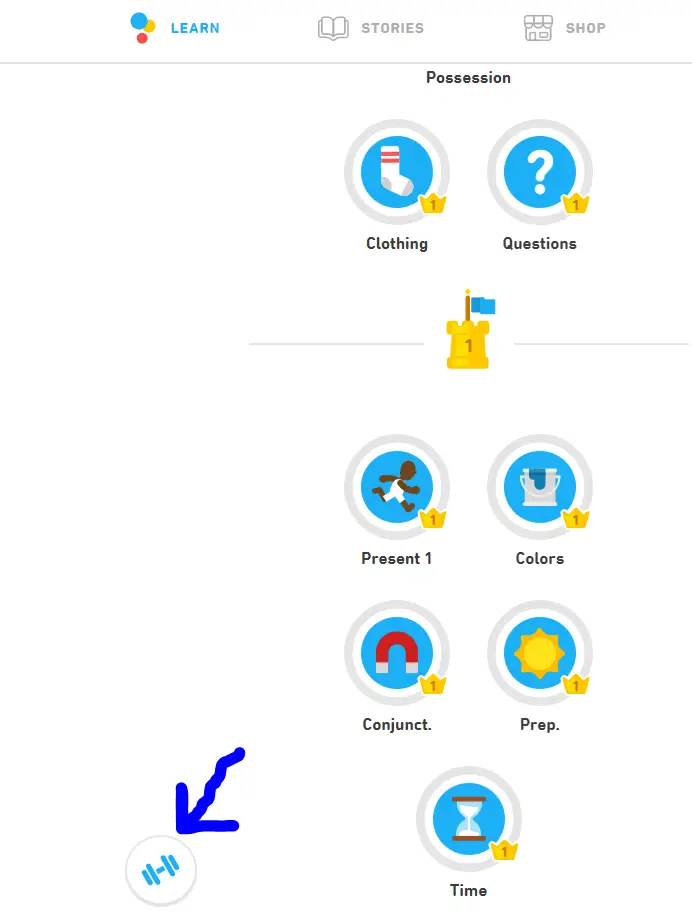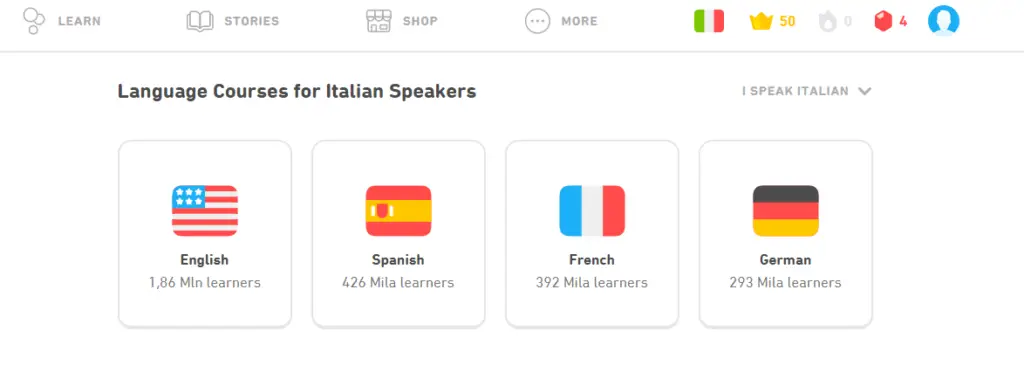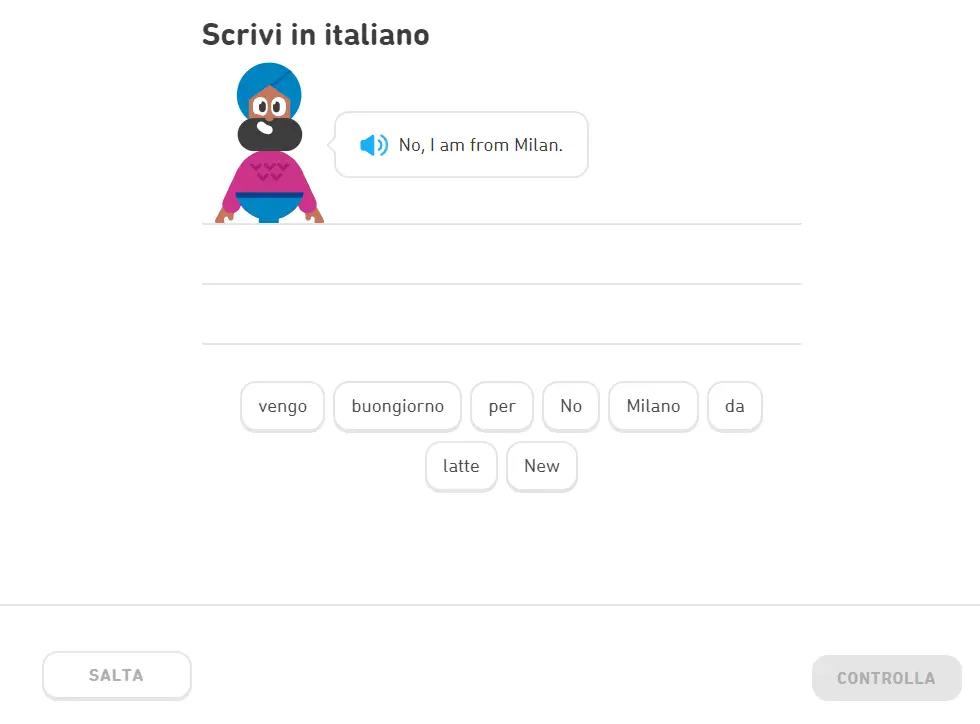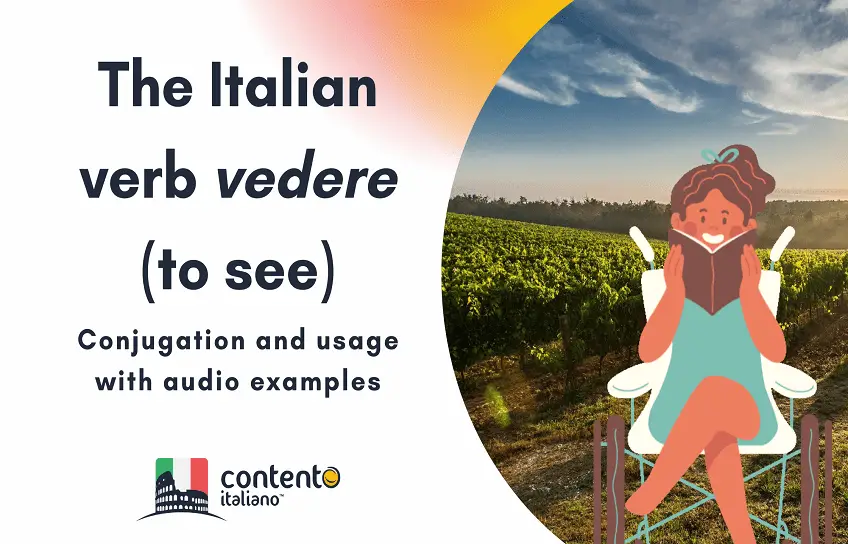If you have completed the Italian tree in Duolingo, you will have acquired the basics in Italian and will have a good background for further learning, although it is unlikely that you will be fluent at this point.
As a general rule, language apps get you to practise a limited set of examples, scenarios and rules, and so they are not suitable for higher levels of language learning.
Your next steps after Duolingo should be to focus on developing a more all-round knowledge of Italian, with a special focus on speaking and listening, and immersing yourself in the language as much as possible.
This article lists 13 activities that we suggest focusing on after you have completed your Italian tree in Duolingo.
These are all based not only on what I see students of Italian do successfully, but also on what I did when I taught myself English, and they are all valuable methods to expand your knowledge of a language. We advise that they are used in combination.

1. Get some private Italian tuition
Private Italian tuition is no doubt the most efficient way to make quick progress in Italian. This is because, in a private session, 100% of the teacher’s attention is on you and your particular needs at that moment.
Here are some of the advantages of private Italian tuition:
- The teaching can be completely tailor made to you
- There is unlimited time for your questions to be answered during a session
- You get to have conversations with a native Italian speaker (assuming the teacher’s first language is Italian)
- Yourself and the teacher can change the direction of each lesson, if this is beneficial, without disrupting the experience of the rest of the class
There are only two cons to private Italian tuition:
- Private Italian tuition is usually less affordable than group tuition or other learning tools
- During a private session you don’t get to practice with other students
We would advise getting at least some private tuition in your Italian learning journey as this will really boost your learning.
If you have just completed the Italian tree in Duolingo, this is a good time to consider private tuition, since you’ll already have a good basis in Italian. We recommend private tuition at any stage in your learning, however.
2. Find someone you can speak Italian with
If private Italian tuition is not an option, we recommend finding someone that you can speak Italian with at no cost. This can either be another learner of Italian or a native Italian speaker you might know through friends, family or connections.
Conversation allows you to put the Italian you have learned into practice and pushes you out of your comfort zone by challenging you in two ways:
- You have to put sentences together and find ways to convey what you want to convey
- You have to understand what the other person is saying
The added advantage of practising your Italian with a native Italian speaker is that they will correct you if you go wrong.

3. Work your way through an Italian conversation book
If you have just completed the Duolingo Italian tree, it is likely that you’ll have a good basis in Italian. Using Duolingo alone, however, is unlikely to make you strong at conversation.
Being able to hold a conversation is the main target for most learners of Italian, and so it’s important that you complement Duolingo with other activities aimed at strengthening your conversation skills.
Because Duolingo is an app, it doesn’t feature conversation exercises. Furthermore, users of Duolingo have commented that the sentences used in the Duolingo course do not apply to “real life”.
To improve your conversation skills, we advise working your way through a conversation book and reading the conversations out loud, either on your own or with a friend.
There are many great Italian conversation books out there and, as a starting point, we recommend Italian Conversation by Collins Easy Learning.

The book takes you through Italian conversations of increasing levels of difficulty for different types of scenarios and also includes concise and simple explanations around why things are said in a certain way.
The main strength of Italian Conversation is that it is full of idiomatic sentences and set phrases for everyday use which would be hard to come up with if you were translating literally from the English language.
In fact, if you are a learner of Italian from English, you may have already discovered that Italian has many set phrases, expressions and sentence constructions which are different to the English language, and so don’t translate literally.
4. Work your way through an Italian grammar book
If you have just completed the Duolingo Italian tree, it is likely that you’ll have a background in Italian grammar at all levels, beginner through to advanced.
However, Duolingo has several shortfalls when it comes to teaching grammar. Duolingo teaches languages mainly through an implicit method that is, by letting the user discover grammar rules through exposure to examples.
The implicit method of learning is very effective for babies and children and, in fact, babies learn language implicitly. In adults, however, a combination of implicit and explicit learning works best.
Explicit grammar explanations are indeed present in Duolingo but they are limited, and many of Duolingo’s users have commented that, for Italian, the grammar explanations are insufficient for the user to really grasp complex grammar topics and that more explicit instruction would be beneficial.
After completing the Duolingo Italian course or, indeed, alongside it, we recommend working your way through an Italian grammar book. In a book, you will find detailed explanations of each grammar topic and a wide variety of examples, including exceptions to grammar rules.
5. Start reading in Italian
Reading, not only in Italian, but in any language, is an excellent way to improve your vocabulary and your flexibility in using the language.
Reading will be very helpful in progressing your Italian, but, if you are a total beginner, we recommend starting with something very simple, otherwise you will struggle to follow along, which will make the experience frustrating.
Short stories which have been simplified for learners of Italian or children’s books are a great start. When you feel more comfortable, you can move to books that you have read before in your native language and that you know well.
6. Watch TV, films and YouTube in Italian
The Italian course in Duolingo only trains you in very basic listening skills. The course has a limited number of voices and, although their pronunciation is correct, Duolingo users have complained that they sound too artificial.
In order to improve your Italian listening skills, it is important that you become exposed to as many different voices in as many conditions as possible.
Some examples of variations in voices are:
- Gender of the speaker
- Age of the speaker
- Background noise
- Different emotions in the voice
- Tone of voice
- Regional inflection (often present even in speakers of standard Italian)
For learners of any language, getting trained in listening to degraded speech is very important. Degraded speech is when the quality of the sound is negatively affected by factors such as background noise or transmission over the phone.
Understanding degraded speech is very important for the use of a language in everyday situations. For example, getting directions for someone if you are in a noisy road or understanding what someone is saying over a disturbed phone line.
Watching TV, films and YouTube is really important in training your listening of everyday Italian. In the same way as reading, listening can be a frustrating experience at first, because it is likely that you will struggle to follow everything that is being said. If possible, start with a film or program that you already know or use subtitles.

It is also important to bear in mind that becoming proficient at listening in a foreign language takes time and therefore patience, and acceptance that you will miss chunks of what is being said, are key.
There is a wealth of video resources in Italian that are free to access on the internet. In terms of TV programs, there are two in particular that we would recommend:
- Don Matteo
Don Matteo is an Italian TV series that has been airing since the year 2000. It is about Father Matteo, a catholic priest in a small town in Umbria (central Italy) who is talented at investigating local crime.
Don Matteo, the protagonist, speaks in standard Italian, but you will also hear Umbrian, Roman and Sicilian inflections in the program. Don Matteo may also be useful for your understanding of the Italian culture, since it portrays daily life in a small Italian town accurately and without filters.
A version of Don Matteo subtitled in English is available, and can be purchased from Amazon.
- Inspector Montalbano
Inspector Montalbano is another popular Italian TV series based on the detective novels of author Andrea Camilleri.
Inspector Montalbano features primarily the Sicilian accent and inflection, but also standard Italian. From a cultural point of view, Montalbano portrays life in Sicily without filters, so it may be of interest to you if you would like to get a feel for the Italian and Sicilian culture.
Inspector Montalbano is available with English subtitles on BBC, Amazon, MHz World View and SBS.
7. Listen to podcasts and music in Italian
Getting proficient at listening in a foreign language takes years of practice and exposure.
If you have completed the Duolingo Italian tree and have not used any other Italian learning method, it is possible that your Italian listening skills might still be at a basic level.
In order to improve your listening skills in Italian and your all-round knowledge of the language, we recommend listening to Italian podcasts (for example News in Slow Italian) music.
The advantage of podcasts and music is that you can listen to these while you are doing other things (and even in your sleep) which makes it easier to build them into your routine.
Music and singing along, are particularly helpful in developing your listening and pronunciation of a language because:
- You memorize words better by associating them with the melody
- You are “forced” to break words up into syllables when you are singing, which improves your pronunciation
8. Practise writing in Italian
Even if your main focus with Italian is learning to speak and have a conversation, writing is a very useful exercise, particularly handwriting.
Writing helps you to memorize words better and to focus on what you are trying to convey. Practising your spelling also helps you to understand the Italian phonetics better, and so will also aid your reading.

Top tip:
A very useful exercise for both your listening, reading and writing in Italian is to pick a song you like, find the lyrics and sing along.
If you are very committed, it is also very helpful to write the lyrics down yourself on a separate piece of paper and sing along to these.
If you are very motivated, another great exercise is to keep a diary in Italian and write in it each day what you did, your thoughts and so on. This will really get you thinking about vocabulary and the structure of sentences, and it will get you to focus on the Italian that is relevant to your life specifically.
10. Keep building your vocabulary
Over the Italian course in Duolingo, you’ll have seen (or you will see) just under 3,000 lexemes, that, is words or word combinations.

Although this is a very good start in terms of building your vocabulary and knowledge of Italian, it is likely that, at the end of the Duolingo course, you will still be missing many words to be able to hold a complete conversation and your vocabulary will still have gaps.
For this reason, we recommend that, after finishing the Duolingo course, you keep building your vocabulary through reading, watching and listening.
9. Refresh your memory of Italian words
Use flashcards on a regular basis to support your memory of the words you already know and the of the new ones you are learning. One good tool that you can use to build your own flashcards is Quizlet.
Duolingo also has a feature called “Words” which allows you to see the words that you have learned. You can use this list as a basis for your flashcards.

Finally, to further consolidate what you have already learned in Duolingo, you can use the “practice” function in the bottom left corner of your screen to go over what you have learned again.

11. Do the reverse Duolingo tree
Another way to consolidate what you have already learned in the Duolingo course is to complete the “reverse tree” in Duolingo.
For example, if you are a speaker of English who has just completed the Italian course, the reverse Duolingo tree for you would be to complete the English course for Italian speakers.
In order to do this, you need to first go to the courses page and set your language to Italian. The menu will now say “I speak Italian” in the top right corner:

Then choose English as your language course.
What you should have now is an “English from Italian” Duolingo tree, where Duolingo aims to teach you English assuming that your first language is Italian.

The reverse Duolingo tree is useful for many students who have completed the Italian Duolingo course and would like to consolidate and refresh their knowledge but don’t want to go through exactly the same course that they’ve already done.
12. Revise verb conjugations and tense usage
There are several aspects of the Italian grammar which are particularly challenging for those who speak English as their first language. Check out this post to find out what they are:
Just How Difficult Is Italian Grammar?
If you have just finished the Italian Duolingo course, we would advise revising verb conjugations and tense usage to keep them fresh.
Although this may not be the hardest grammar topic to understand, it is the topic that requires the largest memorization effort when learning Italian. If it’s any consolation, think that Italian children have to memorize verb conjugations themselves when they are in school.
You may find our articles on Italian verbs useful for your revision. This is a series of posts that goes through each Italian verb tense and shows you how it is used through examples:
13. Choose another language learning program
If you are interested in completing another online Italian course after Duolingo, there are many affordable options out there.
Some of the most popular are:
- Babbel (more challenging than Duolingo, and greater focus on teaching grammar rules)
- Rosetta Stone
- Pimsleur
- Memrise
In conclusion: what should you do after Duolingo?
If you have completed the Italian course in Duolingo and wish to progress with your learning, we recommend that you immerse yourself in the language as much as possible, with a specific focus on listening and speaking.
Depending on how much time you have available and how much effort you wish to invest into learning Italian, we suggest that you use a combination of the activities discussed in this article, prioritizing the ones that work best for you and that you enjoy the most.









